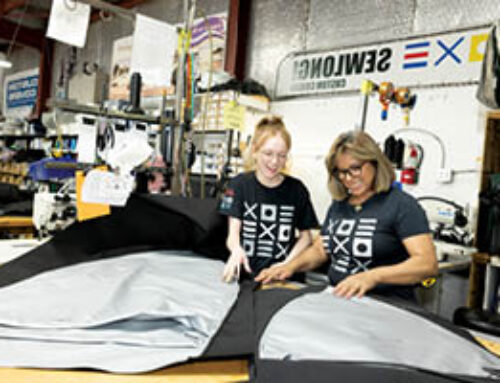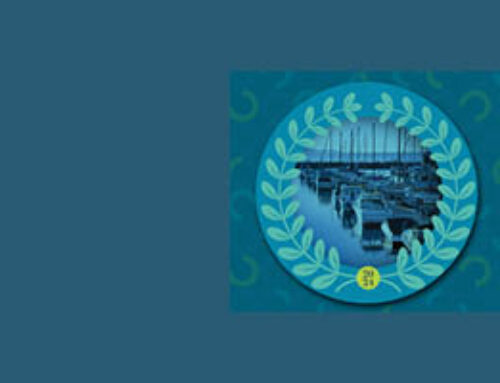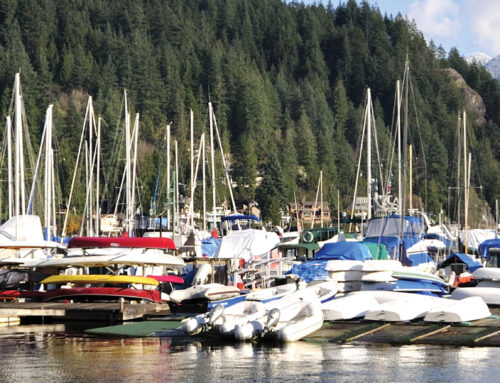Better safe than sorry
State and federal regulations—and common sense—keep shops safe.
By Mason Riddle
Marine shop safety entails more than the classic red and white first-aid kit filled with Band-Aids, Neosporin and ibuprofen. And what constitutes safety varies from shop to shop, depending on what is being fabricated, the number of employees and clientele. Local fire marshals and the federal Occupational Safety and Health Administration (OSHA) also have their rules and regulations to be followed.
David Ferkul and Ryan Nosan, Minnesota’s OSHA representatives, make clear that the administration’s requirements are in place for the protection of employees and to ensure that employees are protected from the hazards that may be present in their workplace. The go-to bible for the do’s and don’ts of safety are found in OSHA’s 29 CFR 1910 General Industry Regulations. “An employer engaged in this type of work would follow OSHA’s 29 CFR 1910 General Industry Regulations and any other state-specific OSHA rules for safety and health,” say Ferkul and Nosan. “These OSHA standards are a set of minimum requirements that businesses must implement to protect employees from the hazards associated with this type of work.”
The pair also clarify that OSHA does not promote or recommend specific tools for employers’ use, yet they note requirements are explained in 29 CFR 1910 for specific work area and equipment requirements. “For example, certain types of engineering controls (guarding, built into the design of the equipment) must be in place to protect workers from said hazards,” said Ferkul and Nosan via email. “A job-hazard analysis of the work areas and work tasks will identify potential hazards that increase the risk of employee injury or illness. From the analysis, appropriate control measures can be determined. This can eliminate the hazard through physical guarding and substituting to a less hazardous material, work practice and other administrative controls, and use of personal protective equipment (PPE).”
OSHA also requires employers to complete a hazard assessment to determine what types of PPE are required based on hazards to which the employees are exposed in the workplace, and 29 CFR 1910 lists PPE requirements that vary with the task. One example is if employees are exposed to an overhead hazard, a hardhat is required. Or, if an employee is exposed to flying sparks or chips, eye protection and, potentially, a face shield is needed.
Ferkul and Nosan note that first-aid requirements are defined in OSHA’s 29 CFR 1910.151 and in 1910.157 for fire extinguishers. “These sections of the OSHA regulations lay out specifically what is required for different size businesses and the hazards that are present in the workplace,” they explain. “Other specific standards also have requirements for first aid and fire extinguishers.”
They cite examples. “Permit-required confined-space entry (1910.146) has specific requirements for trained first-aid providers. Spray finishing with flammable liquids (1910.107) has specific requirements for fire extinguisher availability. These requirements would need to be followed if applicable to the worksite.”
What about onsite defibrillators, which are becoming more common in offices, workout facilities and public spaces? “Automated external defibrillators can be beneficial at all worksites,” Ferkul and Nosan say. “Each worksite should assess its own requirements, as part of the worksite first-aid program.”
Regarding worker fatigue, workplace hours and schedules vary from shop to shop and the season. At Canvas Designers Inc. in Riviera Beach, Fla., owner Mike Erickson employs 63 people across his metal fabrication shop, the custom marine upholstery shop (including embroidery, drapes, bedspreads and carpets), and such traditional exterior canvas work as boat toppers and covers. Staff works four 10-hour days, Tuesday through Friday, from 7:30 a.m. to 6 p.m. They have two 10-minute breaks and up to an hour for lunch. “We work on everything from 13-foot whalers to 350-foot super yachts,” Erickson says. “Everyone works hard and on this schedule everyone has three days off in a row.”
Faith Roberts of Banner Canvas in Ham Lake, Minn., employs three to four people. “I seem to work 12 to 18 hours a day,” she states. “In the height of the season, it can be seven days a week. It is intense and can wear on you. My employees may work 10 hours a day five days a week. I may ask for a day with more hours to get a job done, but they get the time off after we are finished.” She says her employees have flexible schedules whenever possible, and that if they are too tired, for whatever reasons, “They know I would never tell them to do it, anyway. I would never risk their health and safety,” she says.
Erickson had a complete fire sprinkler system installed in his Canvas Designers shop and he recently assigned an employee to be the in-house safety officer to oversee his three shops. They hold quarterly, staff-wide safety meetings, and staff are instructed to address any problems with the safety officer. Erickson also notes that OSHA educational videos are available.
The Canvas Designers shop is fully equipped with the requisite safety kits, safety glasses and fire extinguishers, and the local fire marshal examines the shop on an annual basis so corrections can be made and certified. No open-toed shoes or flip-flops are allowed. And clients are not allowed into the fabrication areas.
“In the end, insurance is cheaper if you have a safe shop,” notes Erickson. Erickson also requires a two-man crew for fabrication and installation on boats. “We recently worked on a 200-foot boat. When a large boat in the yard is 60 feet in the air, safety is absolutely a requirement,” he says. “When my staff is up in a tower they are harnessed and tied off in case of falls. There is always one person watching for fire if another is welding, and every fitter has a helper.”
Roberts also has an annual shop inspection by the local fire marshal. When she built her 4,000-square-foot shop north of Minneapolis in 1998, the property was inspected and it is compliant with the Americans with Disabilities Act, including ramps and bathroom accessibility. Clients cannot get very far past the door. She has four fire extinguishers that are certified every year. She also has 3M ventilator masks for spraying glue or paint, and gloves for handling fiberglass, wood and rough products. Earplugs are on hand for noise abatement, and safety glasses and dust masks are used on a regular basis.
Roberts also insists that equipment, such as ladders and drills, is in good shape. “I stock the shop with good tools—I prefer Snap-on. They are expensive but high-end,” she remarks. “Every year, I go through all of the drill bits and throw out what is not in good shape.” The aisles between worktables are a regulation 32 inches wide, and electrical cords are rolled up and not more than six feet in length so staff does not trip. Chemicals are stored in a stainless steel cabinet, the location of which is known to the fire marshal in the event of a fire. She keeps Material Safety Data Sheets on all chemicals.
Hood Marine Canvas, in business since 1981, operates on a smaller scale. Mark and Deb Hood essentially make patterns and fabricate all of their tops, covers and upholstery. They also run a school and teach approximately 60 students a year in marine canvas fabrication. “We do about 50-50 sailboats to power boats, and we service only our previous customers in terms of repair work,” Mark states. “We focus on boats 22-feet and larger, and are probably better known for our sailboat work, but we do both.”
Given the small scale of their work force, the Hoods have modest safety precautions in place. “Of course, Debbie and I are mindful of everything,” Mark says. “We’ve been doing this a long time. We have a safety kit, fire extinguishers and safety glasses. When we are installing on the water, we wear inflatable devices around our necks in case we fall in. We also require owners of very large boats to build staging in the boat yard for our pattern work. It can be a long fall from a 65-foot boat.”
The Hoods work as many hours in the day as are needed to complete a job and their schedule fluctuates. They both teach classes on top of their fabrication projects. Mark notes they have installed needle cards on their seven sewing machines for their students. They have also replaced the older sewing machine AC clutch motors with DC servo motors. “The DC servos are much safer for the students,” he explains. “It’s much easier to regulate the speed of the machine, and it is much smoother to operate.”
According to OSHA’s Ferkul and Nosan, a best practice is to lead by example. “If employees are required to wear PPE, the owner or operator should follow the same rules,” they say. “This practice should be extended to all clients and guests to ensure they are also protected while in your place of business.”
Ultimately, they recommend that an employer acquire the guidelines that cover their industry and understand the applicable rules and regulations. “The federal OSHA website features safety and health standards, hazard alerts and other guidance,” Ferkul and Nosan explain. Some state-specific OSHA programs feature their applicable rules and potential training opportunities. They also note that employers can request an OSHA on-site consultation: An OSHA consultant visits the worksite to identify potential hazards. In return, the employer works to correct the items within an agreed upon timeframe. “It is a free and confidential service that provides safety and health assistance to small, high-hazard employers,” they state.
Ferkul and Nosan believe employers benefit greatly from OSHA’s free consultation service. “Operations can run more efficiently when hazards are identified and corrected. Lost work time due to injuries and illnesses may decrease, saving money and human resources. Workers’ compensation premiums may decrease due to fewer claims and lower experience modification rates.”
Mason Riddle is a freelance writer from Minneapolis, Minn.
 TEXTILES.ORG
TEXTILES.ORG 






